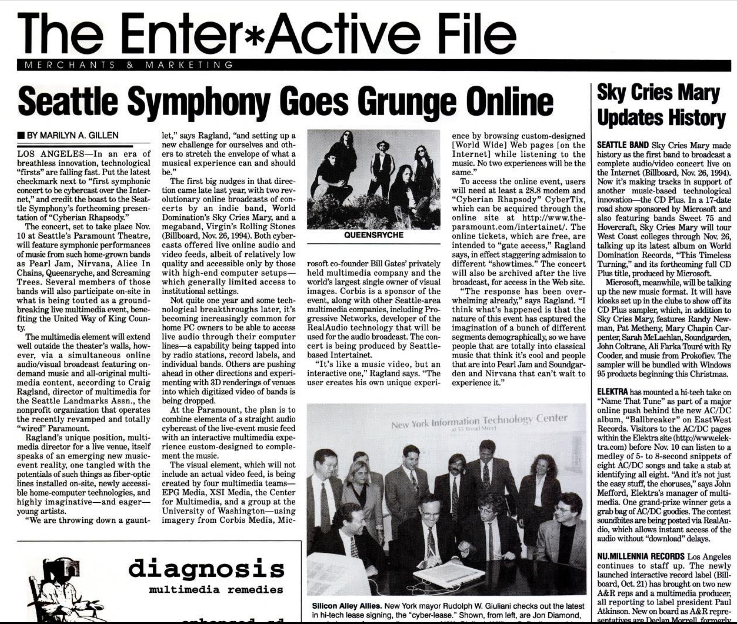With video increasingly becoming the medium of communication over the internet, it is a sobering thought that many of the technologies now being used seamlessly were tried out, at enormous usage costs, in the early-to-mid 90s. Some of the first uses of internet streaming media in this period were:
- The first major live sports webcast on the internet on September 5, 1995 – a Major League Baseball game between the Seattle Mariners and the New York Yankees.
- A Rolling Stone Live Concert was broadcast live from Cotton Bowl in Dallas on 18 November 1994. Knowing the broadcast channel to be live and open to anyone, Severe Tire Damage, a band created by employees at Xerox PARC at Palo Alto, CA broadcast an impromptu performance live before and after the Rolling Stone Broadcast. The broadcast was still not accessible to a wide audience – the workstation required for receiving the broadcast and the telephone connection (which would have then cost $20,000) meant that only about 200 computers were logged in for the broadcast.
- On November 10, 1995, Seattle Symphony [1] performed the first symphonic concert live with guest musicians Slash (Guns ‘N’ Roses, Velvet Revolver), Matt Cameron (Soundgarden, Pearl Jam) and Barrett Martin (Screaming Trees). To access this online event, users would have required a 28.8 modem and a “Cyberian Rhapsody” CyberTix. The visual element for the stream was created by four multimedia teams – EPG Media, XSI Media, the Center for MultiMedia, and a research group at the University of Washington. The imagery was provided by Corbis Media, privately held by Microsoft Chairman Bill Gates.

What follows is the story of the evolution of Streaming Media, and the struggle for dominance between RealNetworks and Microsoft in the Dot Com era, and post that the emergence of Flash and Apple in the streaming media space.
RealNetworks and Microsoft – Streaming Media in the Dot Com Bubble
Microsoft’s involvement in streaming media was initiated in 1993, when they sent Windows development kit videos to developers.
Progressive Networks launched RealAudio 1.0 in April 1995. With this they launched the first streaming media application. VDOnet, Xing and Microsoft were three other companies that were developing platforms for streaming technologies. Xing’s platform – StreamWorks – supported both audio and video and was launched shortly after the launch of RealAudio 1.0.
In 1997, RealNetworks (rebranded from Progressive Networks) agreed a broadcast network deal with MCI Communications (who were one of the most important telecommunications company in the 90s).[2] The goal for this deal was for MCI’s internet infrastructure to provide support for upto 50,000 simultaneous streams. This was the first major effort towards creating a content delivery network (CDN) for reaching out to mass media consumers.
Soon, the increasing significance of streaming media and the related support services of encoding, delivery and hardware led to specialized technologies in each field. Both Sun and Cisco were early entrants into the hardware market for streaming media. Also MP3 and MPEG file format licenses were very expensive, and the competition between Microsoft and RealNetworks was largely around cornering the standards for codecs – if the RealNetwork codec became standard then they would have had control over licensing, thereby being de facto leaders of the streaming media industry.
The Dot Com bubble burst in 2000-01, and the expected demand for streaming media was not achieved. RealNetworks started focusing on content, creating a content subscription service called RealOne. They also announced a three-year deal in 2001 with Major League Baseball to create subscription service for live audio webcasts. By 2003 RealNetworks had initiated its exit from the streaming media business, announcing a partnership with Sony, following that up with acquiring music and gaming companies over the years.
iPod and iPhone – Apple takes over
Microsoft, the incumbent leader in the streaming media space, largely disregarded the emergence of Apple in the field of streaming media, leaving it to the entertainment division to compete with the emerging iPod. Apple had released iTunes for Windows. Flash emerged as a streaming + encoding solution, and Apple followed up their entry with their HTTP Live Streaming (HLS) protocol. HLS is now being used by Apple Devices for adaptively streaming both live and on-demand files. Flash remains the incumbent video streaming technology, with the fragmentation in HTML5 making the shift to the newer technology not as popular as was previously expected.
References:
- “Seattle Symphony Goes Live”, Billboard, November 1995
- New York Times, 22 November 1994
- Dan Rayburn, StreamingMedia Magazine
Supercharge Your Business with Videos
At VdoCipher we maintain the strongest content protection for videos. We also deliver the best viewer experience with brand friendly customisations. We'd love to hear from you, and help boost your video streaming business.
